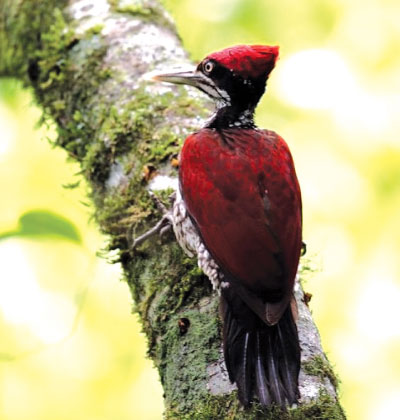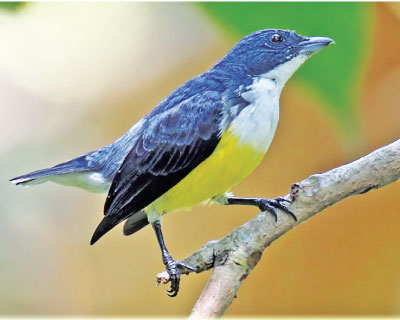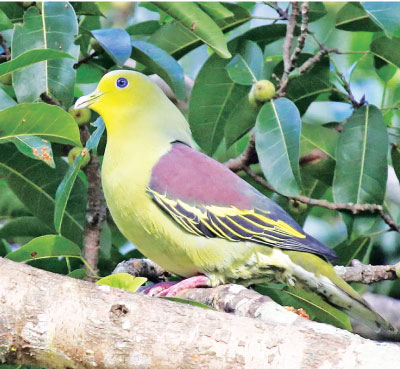Nature is something we children take for granted. Growing up in this technology savvy world with smart phones and video games we forget what's around us. But there is a positive side to this, and that's the use of a smart phone for taking pictures of these beautiful creatures of nature. So on your school holidays when you go on trips don't forget to take your smart phone with you.
 Large golden-backed woodpecker
Large golden-backed woodpecker
The greater flameback (Chrysocolaptes guttacristatus) also known as greater golden back is a large golden-backed woodpecker or Malherbe's golden-backed woodpecker is a woodpecker species. It is seen widely in the Indian subcontinent, eastwards to southern China, the Malay Peninsula, Sumatra, western and central Java and northeast Borneo. It is 33 cm in length and is of typical woodpecker shape, has an erect crest and a long neck. Its colour is highly variable between subspecies; it always has unmarked golden-yellow to dark brown back and wings. The rump is red and the tail is black. The underparts are white with dark markings (chevrons, stripes, or bands), or light brown. The head is whitish with a black pattern, or it is yellow, brown or red. The straight pointed bill is long (longer than the head) and – like the legs and four-toed zygodactyls feet (two toes pointing forward, two backward) – lead-grey. The eyes’ irides are whitish to yellow. The adult male greater flameback always has a red crown. Females have a crown colour varying between subspecies, such as black spotted with white, yellow, or brown with lighter dots. Young birds are like the female, but duller, with brown irides.
Legge's flowerpecker
The Legge's flowerpecker or white-throated flowerpecker (Dicaeum vincens) is a small perching bird. It is an endemic resident breeder in Sri Lanka. It is named after the Australian ornithologist William Vincent Legge (thus the name Legge).
The Legge's flowerpecker is a common resident breeding bird of forests and other well-wooded habitats including gardens. Two eggs are laid in a purse-like nest suspended from a tree.
This is a very small, stout flowerpecker, 10 cm in length, with a short tail, short thick curved bill and tubular tongue. The latter features reflect the importance of nectar in its diet, although berries, spiders and insects are also taken.
The male Legge's flowerpecker has blue-black upper parts, a white throat and upper breast, and yellow lower breast and belly. The female is duller, with olive-brown upper parts.
 Pompadour green pigeon
Pompadour green pigeon
The pompadour green pigeon (genus Treron) is a pigeon species complex. It is widespread in forests of southern and southeast Asia. It is a widespread group in forests of tropical southern Asia from India, Sri Lanka east to the Philippines and the Moluccas. In India, they are found as disjunct populations.
The pompadour green pigeon complex are all stocky, medium-sized pigeons, 25 to 28 centimetres (9.8 to 11.0 in) in length, with some significantly larger than others (e.g., chloropterus is significantly larger than birds from the Asian mainland). The head is green to greenish-yellow, and the under parts are green, though males of the subspecies phayrei have a pale orange patch on the chest. The crown, including the forehead is usually grey, except in Sri Lanka. Green pigeons forehead is greenish-yellow. The under tail coverts are mainly whitish or pale yellowish, though they are deep cinnamon in males of affinis and phayrei. The wings are blackish with distinct yellow edging to the wing coverts and tertials. The mantle is dark green in the female and deep purplish-chestnut in the male. In most birds, this includes the “shoulder”, but in males of aromaticus the “shoulder” is very dark grey and in males of chloropterus it is green. Furthermore, males of aromaticus and some members of the axillaris group have a grey band above the mantle.
The legs are reddish in most birds, but grey in the axillaris group. The eyes are maroon-red or deep to very light blue (depends on subspecies), and the bill is whitish-grey with a dull, pale greenish or bluish base, except in the axillaris group where the base is red.
All species of the pompadour green pigeon complex usually occur singly or in small groups. Flight is fast and direct, with the regular beats and an occasional sharp flick of the wings that are characteristic of pigeons in general. They eat the seeds and fruits of a wide variety of plants. They build a stick nest in a tree and lay two white eggs. So now it will be easy for you to identify these birds.
- Internet
